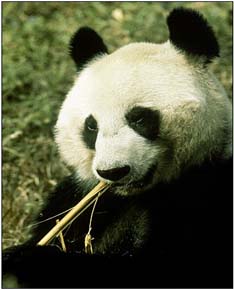
Today, the pandas are measured by the hundreds, especially due to their peculiar but persistent feeding habits.
Pandas are world-renowned creatures and are very much endangered. In fact it was, and still is, so endangered that when the World Wildlife Fund was established, it chose the panda as its logo and mascot. At that time, pandas are measured by the thousands. Found deep within the forestry of China, generally in cool, damp bamboo forests at altitudes reaching 3500 metres. They do take shelter in hollow trees, rock crevices, and caves as well. Despite having a big frame and often being regarded as clumsy, the panda is surprisingly able to climb trees.
 |
Characterized by its
infamous dual colour body, only the ears, eye patches, muzzle, hindlimbs, forelimbs and
shoulders are black, the rest of its gigantic chassis is plain white. The shoulder height
of the panda is 70 to 80 centimetres, and when standing they can be as high as 170
centimetres. The panda is also distinguished by its opposable thumb, an extra digit on its
forepaw, which is actually an extension of a wrist bone. Today, the pandas are measured by the hundreds, especially due to their peculiar but persistent feeding habits. |
In their upright feeding positions, with the use of their opposable thumbs which allows them to grab, tear, and manipulate their food with relative ease, they spend 10 to 12 hours each day feeding. The average daily consumption of bamboo is a massive 12.5kg. While their primary source of food comes from bamboo, they also consume insects, bulb grasses, and rodents.
However, without bamboo roots and shoots, the great panda of western China is almost certain to starve to death. It is one of the rare specialized feeders, nearly only feeding on the bamboo roots and shoots. Though this substantially reduces the chances of pandas' survival, it does have its advantages. One of which is that such a specialized diet diminishes the competition among species in one habitat. Thus, that particular habitat is able to support many different animals at one time.
This is not to forget that a specialist is more inept when their food supply declines. The specialists are at the mercy of their food supplies. They are better at exploiting a particular food source, while generalists are better coping with fluctuating availability of food sources, with a greater chance of survival.